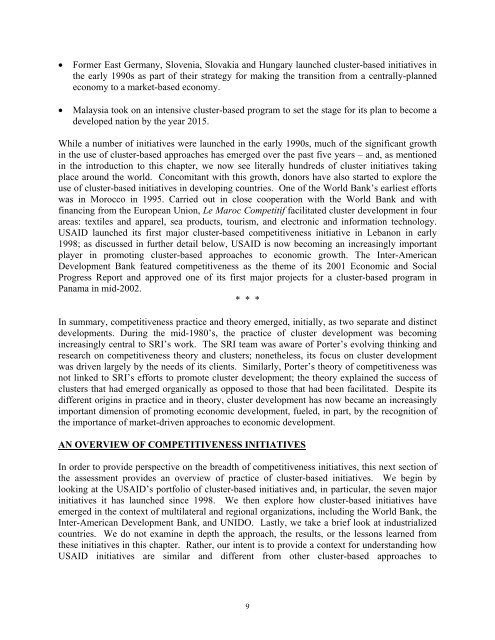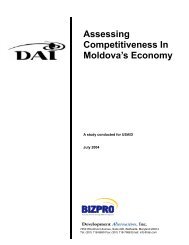Promoting Competitiveness in Practice - Economic Growth - usaid
Promoting Competitiveness in Practice - Economic Growth - usaid
Promoting Competitiveness in Practice - Economic Growth - usaid
You also want an ePaper? Increase the reach of your titles
YUMPU automatically turns print PDFs into web optimized ePapers that Google loves.
• Former East Germany, Slovenia, Slovakia and Hungary launched cluster-based <strong>in</strong>itiatives <strong>in</strong><br />
the early 1990s as part of their strategy for mak<strong>in</strong>g the transition from a centrally-planned<br />
economy to a market-based economy.<br />
• Malaysia took on an <strong>in</strong>tensive cluster-based program to set the stage for its plan to become a<br />
developed nation by the year 2015.<br />
While a number of <strong>in</strong>itiatives were launched <strong>in</strong> the early 1990s, much of the significant growth<br />
<strong>in</strong> the use of cluster-based approaches has emerged over the past five years – and, as mentioned<br />
<strong>in</strong> the <strong>in</strong>troduction to this chapter, we now see literally hundreds of cluster <strong>in</strong>itiatives tak<strong>in</strong>g<br />
place around the world. Concomitant with this growth, donors have also started to explore the<br />
use of cluster-based <strong>in</strong>itiatives <strong>in</strong> develop<strong>in</strong>g countries. One of the World Bank’s earliest efforts<br />
was <strong>in</strong> Morocco <strong>in</strong> 1995. Carried out <strong>in</strong> close cooperation with the World Bank and with<br />
f<strong>in</strong>anc<strong>in</strong>g from the European Union, Le Maroc Competitif facilitated cluster development <strong>in</strong> four<br />
areas: textiles and apparel, sea products, tourism, and electronic and <strong>in</strong>formation technology.<br />
USAID launched its first major cluster-based competitiveness <strong>in</strong>itiative <strong>in</strong> Lebanon <strong>in</strong> early<br />
1998; as discussed <strong>in</strong> further detail below, USAID is now becom<strong>in</strong>g an <strong>in</strong>creas<strong>in</strong>gly important<br />
player <strong>in</strong> promot<strong>in</strong>g cluster-based approaches to economic growth. The Inter-American<br />
Development Bank featured competitiveness as the theme of its 2001 <strong>Economic</strong> and Social<br />
Progress Report and approved one of its first major projects for a cluster-based program <strong>in</strong><br />
Panama <strong>in</strong> mid-2002.<br />
* * *<br />
In summary, competitiveness practice and theory emerged, <strong>in</strong>itially, as two separate and dist<strong>in</strong>ct<br />
developments. Dur<strong>in</strong>g the mid-1980’s, the practice of cluster development was becom<strong>in</strong>g<br />
<strong>in</strong>creas<strong>in</strong>gly central to SRI’s work. The SRI team was aware of Porter’s evolv<strong>in</strong>g th<strong>in</strong>k<strong>in</strong>g and<br />
research on competitiveness theory and clusters; nonetheless, its focus on cluster development<br />
was driven largely by the needs of its clients. Similarly, Porter’s theory of competitiveness was<br />
not l<strong>in</strong>ked to SRI’s efforts to promote cluster development; the theory expla<strong>in</strong>ed the success of<br />
clusters that had emerged organically as opposed to those that had been facilitated. Despite its<br />
different orig<strong>in</strong>s <strong>in</strong> practice and <strong>in</strong> theory, cluster development has now became an <strong>in</strong>creas<strong>in</strong>gly<br />
important dimension of promot<strong>in</strong>g economic development, fueled, <strong>in</strong> part, by the recognition of<br />
the importance of market-driven approaches to economic development.<br />
AN OVERVIEW OF COMPETITIVENESS INITIATIVES<br />
In order to provide perspective on the breadth of competitiveness <strong>in</strong>itiatives, this next section of<br />
the assessment provides an overview of practice of cluster-based <strong>in</strong>itiatives. We beg<strong>in</strong> by<br />
look<strong>in</strong>g at the USAID’s portfolio of cluster-based <strong>in</strong>itiatives and, <strong>in</strong> particular, the seven major<br />
<strong>in</strong>itiatives it has launched s<strong>in</strong>ce 1998. We then explore how cluster-based <strong>in</strong>itiatives have<br />
emerged <strong>in</strong> the context of multilateral and regional organizations, <strong>in</strong>clud<strong>in</strong>g the World Bank, the<br />
Inter-American Development Bank, and UNIDO. Lastly, we take a brief look at <strong>in</strong>dustrialized<br />
countries. We do not exam<strong>in</strong>e <strong>in</strong> depth the approach, the results, or the lessons learned from<br />
these <strong>in</strong>itiatives <strong>in</strong> this chapter. Rather, our <strong>in</strong>tent is to provide a context for understand<strong>in</strong>g how<br />
USAID <strong>in</strong>itiatives are similar and different from other cluster-based approaches to<br />
9
















